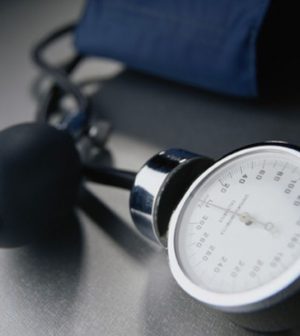- Navigating Your Midlife Crisis: Embracing New Possibilities
- City Raccoons Showing Signs of Domestication
- Mapping the Exposome: Science Broadens Focus to Environmental Disease Triggers
- One Week Less on Social Media Linked to Better Mental Health
- Your Brain Changes in Stages as You Age, Study Finds
- Some Suicide Victims Show No Typical Warning Signs, Study Finds
- ByHeart Formula Faces Lawsuits After Babies Sickened With Botulism
- Switch to Vegan Diet Could Cut Your Greenhouse Gas Emissions in Half
- Regular Bedtime Does Wonders for Blood Pressure
- Dining Alone Could Mean Worse Nutrition for Seniors
Pandemic Sent Americans’ Blood Pressure Numbers Skyward

MONDAY, Dec. 6, 2021 Yet another pandemic-related health woe has come to the fore: rising blood pressure.
Data covering almost half a million middle-aged Americans shows that about 27% saw their blood pressure go up significantly in 2020 after COVID-19 restrictions unfolded compared to the prior year. Women appeared to be particularly vulnerable.
Still, “the blood pressure elevation was not limited to one group, as adults across all ages and both sexes saw blood pressures increases,” noted study lead author Dr. Luke Laffin, co-director of the Center for Blood Pressure Disorders at the Cleveland Clinic.
The findings are not particularly surprising, Laffin said, noting “as the pandemic wore on, people tended to have less healthier habits.” Driven by confinement, they had poor dietary habits, worsening sleep and increased stress, while experiencing prolonged gym closures and a general reluctance to seek medical care.
Laffin warned the uptick “has potential long-term implications, given that even small increases in blood pressure across large population groups increase risk for adverse cardiovascular events.”
High blood pressure is a widespread public health concern, affecting almost half of all American adults, and contributing to heart attack and stroke, according to the American Heart Association.
To examine the potential for a specific pandemic-blood pressure connection, investigators analyzed three years of blood pressure trends — from 2018 through 2020 — amassed by Quest Diagnostics.
The data included blood pressure readings of nearly 464,600 adults — average age 46 — who participated in employee wellness programs across all 50 states.
Laffin and his colleagues found that prior to the pandemic blood pressure remained generally stable.
But once lockdowns were underway in April 2020, blood pressure began a steady climb through the remainder of the year. That was true for both the upper (systolic) and the lower (diastolic) numbers.
The researchers observed that systolic readings rose an average of 1.10 to 2.50 mm Hg every month between April and December, when stacked up against readings taken one year prior.
Similarly, diastolic readings rose an average of 0.14 to 0.53 mm Hg each month.
Generally speaking, women were more likely to see both their systolic and diastolic blood pressure numbers go up during those nine months. Seniors were more likely to see a rise in their upper number, while younger men and women tended to see their lower numbers jump.
Almost 3 in 10 had worse (higher) blood pressure status during that stretch of the pandemic than they had previously, while closer to 2 in 10 had improved blood pressure readings.
The good news: “I do not think we will see a continued upward trend when 2021 data is examined,” said Laffin, “because the introduction of widespread vaccination and newer available treatments likely led to a resumption of more normal day-to-day living.”
Whether blood pressure levels will ever revert to pre-pandemic levels, and when this could be, isn’t known, he noted.
Another heart expert not connected to the study warned of the long-term effects of higher blood pressure.
“These increases could contribute to an increased risk of subsequent heart attacks, heart failure, strokes and renal disease in the United States,” said Dr. Gregg Fonarow, director of the Ahmanson-University of California Los Angeles Cardiomyopathy Center.
It’s vital, Fonarow said, to redouble efforts to focus the public on improving behaviors that can help to rein in blood pressure and heart disease risk, “even when facing a very challenging pandemic.”
Laffin said that means monitoring blood pressure regularly, maintaining a healthy weight, exercising regularly and cutting back on dietary salt.
“And if you’re prescribed blood pressure lowering medications, take them regularly,” Laffin said.
The study findings appear in the Dec. 6 issue of Circulation.
More information
There’s more on COVID’s impact on heart health at the American Heart Association.
SOURCES: Luke J. Laffin, MD, cardiologist and co-director, Center for Blood Pressure Disorders, Department of Cardiovascular Medicine, Cleveland Clinic, Ohio; Gregg Fonarow, MD, director, Ahmanson-University of California Los Angeles Cardiomyopathy Center; Circulation, Dec. 6, 2021
Source: HealthDay
Copyright © 2025 HealthDay. All rights reserved.










